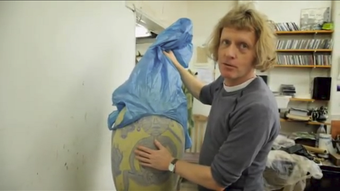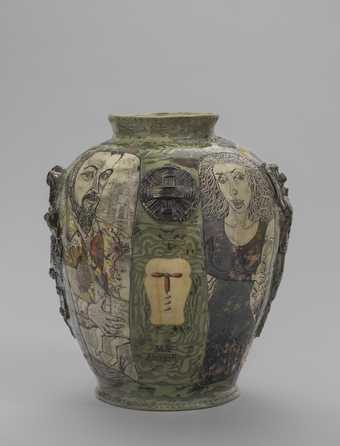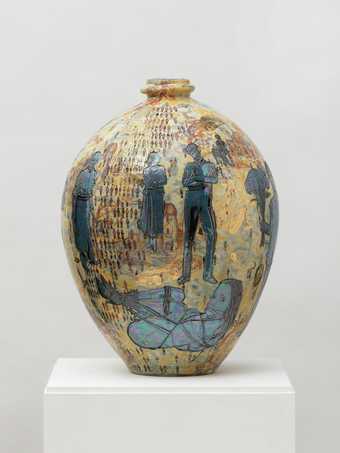Grayson Perry was the surprise winner of the Turner Prize in 2003.
Accepting his award dressed as his alter-ego Claire he commented: 'I think the art world had more trouble coming to terms with me being a potter than my choice of frocks...' In this interview he talks about his love of pots as a medium, the significance of his caustic imagery, and his thoughts on the prize in general.
[In] 2003 I was up against, oh crikeyãÎ the Chapman brothers, Anya Gallaccio andãÎ [laughs] DonãtãÎ Willie Doherty! I will go through it again because IãÎ.no offence Willie but you knowãÎ. We were all kind of quite sort of mature, you know, we werenãt kind of young striplings so that was a good year and everybody was solid but the Chapman brothers were definitely the favourites and everybody assumed they would winãÎ and they didnãt. I like pottery because itãs humble, its not kind ofãÎitãs not hubristic like a lot of contemporary art can be. I like the fact that it offers me a wide range of techniques to work with and I just enjoy the fact that to a certain extent it puts my work outside of, you know, I would have thought in the twenty first century it will be hard to do things that werenãt regarded as contemporary art but actually, you know, I still think there isãÎ there are people who wrestle with the fact that pots could be contemporary art. Well these three works are We Found the Body of Your Child which is about the fact that most child murders are done by the parents and yet all the media attention is always on ãstranger dangerã, I mean thatãs the first, the sort of headline of that piece really though there is other aspects to it. Golden Ghosts was very much about how I felt about identifying, if you like, with children having a hard time all around the world and kind of it looks like a kind of global map of suffering really. Thatãs probably my most kind of, I donãt know, tender piece that I made at the time and the other piece which is A Network of Cracks is a record of the actual seating plan of the Turner Prize dinner the night I won the Turner Prize and is a kind of tribal gathering of the contemporary art world. I suppose the kind of the main image on this vase which is We Found the Body of Your Child is this sort of figure being comforted by a young corpse. I think there is a sort of ambiguity about it, is she being comforted or is she being arrested and the little sort of phrases that are written like ãYou are spoiling me, fucking little shitã, they are kind of like what I would call the thin end of the wedge, you know, in that people they are the kind of things that every parent at some point catches themselves saying to their child and perhaps they are not aware of the kind of war of attrition that they are kind of conducting on their childãs self esteem maybe when they say things like that. Golden Ghosts I am sort of thinking about those maps that you see sometimes that are sort of demographics of religion and this isãÎ and they always have these little sort of symbols sort of showing you know where concentrations of some phenomenon are and this one has got little coffins all over itãÎ sort of the idea that it is kind of the pot as a globe I suppose. I suppose it really is kind of about the preciousness of children and I like the kind of pearliness and goldiness and dreaminess of it. This child was one of those African children in I think it was Sierra Leone where they would sort of go through villages chopping off peopleãs handsãÎ so its quite sort of itãs not a sentimental version of childhood. This pot Network of Cracks is kind of like about the tribal gathering of the art world but around the neck you have the four winners with theirãÎthe four nominees rather with their guests and then you have sort of the VIPs if you like that were there at the event and then there is these long tables that went down the Duveen galleries with the kind of the rest of the guests on. I think the role of the Turner Prize now is slightly different in that I think it is more about promoting younger artists that are less well known whereas I think at the beginning it was like giving kind of recognition to sort of stalwarts of the British art establishment to a certain extent and then it went through this period of its kind of when it was, you know, it was in step with the huge media attention that contemporary art was getting and then now I think itãs sort of the prize is more famous than the artists and it gives, you know, itãs brilliant that it can bring a lot of attention on to younger artists or less well known artists and itãs a great sort of platform for them I think.



